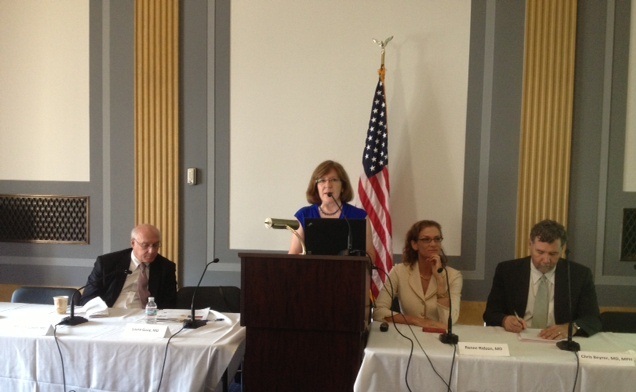On Thursday, leading researchers, including EGPAF Vice President for Research Dr. Laura Guay and global health experts, met to share with an audience of Senate staffers and nongovernmental organizations the latest information on the science behind eliminating HIV. Organized by EGPAF, the Infectious Diseases Society of America (IDSA), and the Foundation for AIDS Research (AMFAR), “Where are we in ending the AIDS Epidemic?: An Update on the Science” provided a thorough overview of the current state of the AIDS pandemic, from pediatric HIV to male circumcision to vulnerable populations most affected by the virus.
Dr. Guay focused her remarks on pediatric HIV. She remembered the beginning of her career working in Uganda 25 years ago, where every baby infected with HIV in the hospital where she worked died. She said that though today “we want to celebrate progress, we can’t give up.” And the progress she described is significant – according to UNAIDS, there has been a 43 percent decline in pediatric infections since 2003, and prevention of mother-to-child transmission (PMTCT) has prevented more than 800,000 child infections. But “children are (still) not getting the treatment they need, “Dr. Guay said, adding that AIDS is a leading cause of death in children under five in high-prevalence countries. In 20 high-burden countries, more than 50 percent of children don’t have access to HIV medications that could save their lives. “Children continue to be left behind in the epidemic.” Dr. Guay pointed to barriers to treatment, including gender inequality, a lack of appropriate drug formulations for children, and a shortage of health care workers. But she ended by saying that with better drugs and expanding coverage, we can reach more children with life-saving treatments.
Dr. Renee Ridzon, a global public health consultant formerly with the Bill and Melinda Gates Foundation, spoke about the role of adult male circumcision in the fight against HIV. As a self-described “evidence-driven pragmatist,” Dr. Ridzon pointed to circumcision as a useful tool in preventing HIV infections worldwide. She said that circumcision was the most cost-effective intervention we have to prevent HIV, and could save nearly $16.5 billion a year. Dr. Chris Beyrer, the president-elect of the International AIDS Society and director of the Johns Hopkins HIV Epidemiology and Prevention Sciences Training Program, shared his thoughts on the “undone work in this extraordinary moment,” and said that though the fight against HIV had created success, those successes had not been shared by the groups most affected by HIV: men who have sex with men, transgender women, injectable drug users, sex workers, and in the United States, women of color. “We are not dealing with a critical part of HIV/AIDS,” he said. Sixty-one percent of new cases of HIV in the United States, he said, are among men who have sex with men, and in the United States, the number of new infections in young gay men of color have risen over the last decade. In Africa, young gay men have the highest HIV rates. But there’s good news: “we have the tools,” he said, saying that antiretrovirals “don’t care how you got HIV.” Getting into treatment early is critical for everyone living with HIV, but young gay men and other at-risk groups tend to be “last in line and least served.” For the fight to eliminate HIV to be successful, he said, this has to change.
The panelists gave the audience a clear, concise, and fact-driven look at the AIDS pandemic. As we continue to work towards an AIDS-free generation, discussions like these will continue to be important.
Jane Coaston is Media Relations Coordinator for the Foundation, based in Washington, D.C.




